
The Renewable Outlook in Japan
Offshore Wind Power Promises to Boost Fukushima Recovery
Science Technology- English
- 日本語
- 简体字
- 繁體字
- Français
- Español
- العربية
- Русский
Powerful Offshore Turbines
The Fukushima Mirai, a floating offshore wind turbine anchored some 20 kilometers off the coast of the town of Naraha, Fukushima, in waters 120 meters deep, has commenced generation and transmission of electricity. Electricity generated by the turbine is transmitted across an undersea cable and supplied to the Tōhoku power grid via lines originating from the Hirono Thermal Power Station, a facility in the town of Hirono operated by Tokyo Electric Power Co. (TEPCO). The electricity from the offshore turbine is enough to power 1,700 households.
The turbine, built by Hitachi Corporation, has three blades, each 40 meters long, and a diameter of 80 meters. It is a downwind-type turbine, which means that its rotor is downwind of the tower. The highest point of the structure is 106 meters above the surface of the sea. The turbine stands atop a 32-meter-high floater made by Mitsui Engineering and Shipbuilding Co.
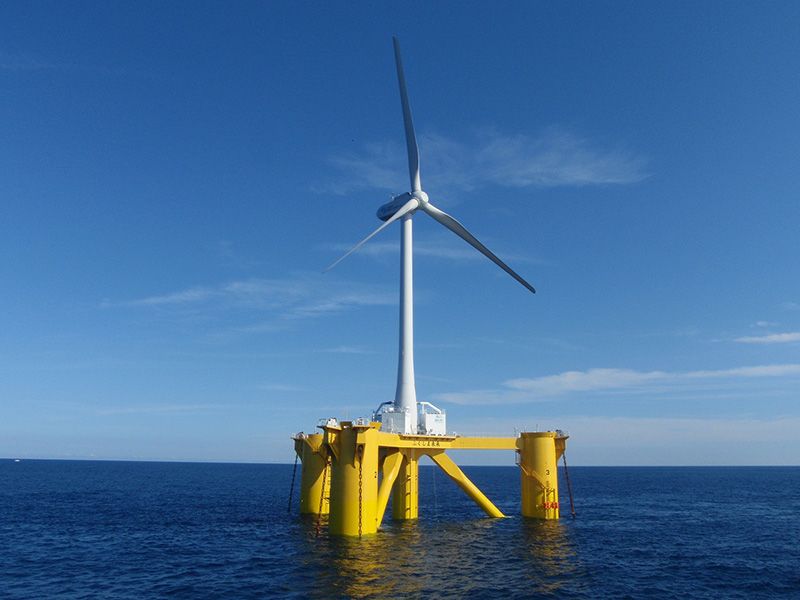 The Fukushima Mirai, a 2,000 kilowatt offshore wind-power generating turbine (photograph courtesy of the Fukushima Offshore Wind Consortium).
The Fukushima Mirai, a 2,000 kilowatt offshore wind-power generating turbine (photograph courtesy of the Fukushima Offshore Wind Consortium).
Anchored in waters two kilometers away from the Fukushima Mirai is a substation, the Fukushima Kizuna; it consists of a transformer to covert the generated electricity to high voltage for transmission to land, and an observation tower for measuring wind direction and speed. The Fukushima Kizuna stands 60 meters above the surface of the sea, and the 66-kilovolt transformer is the first ever to float on the ocean.
Two more generators are to be added during fiscal 2014, both rated among the world’s most powerful at 7,000 kilowatts. The Fukushima Mirai will be positioned in the center, and 1.6 kilometers away on either side will be the two giant turbines with 82-meter blades. Built by Mitsubishi Heavy Industries, the turbines will stand an impressive 187 meters above sea level.
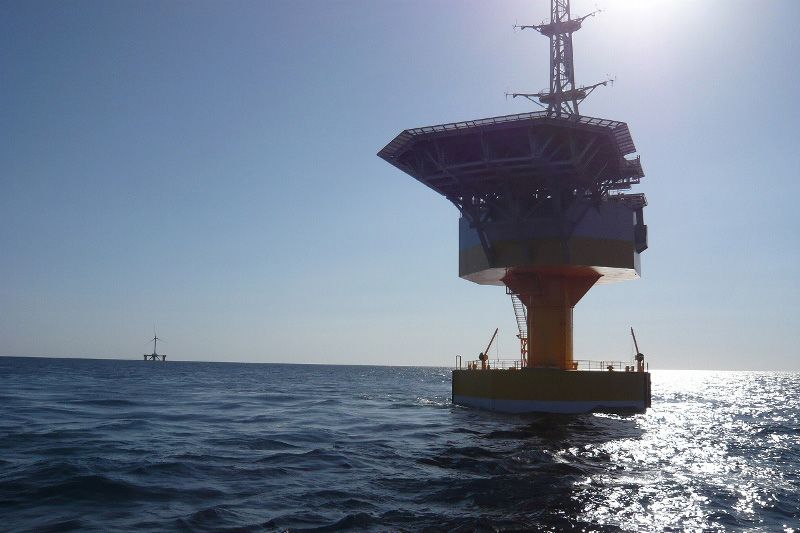 The Fukushima Kizuna floating substation (photograph courtesy of the Fukushima Offshore Wind Consortium).
The Fukushima Kizuna floating substation (photograph courtesy of the Fukushima Offshore Wind Consortium).
Floating Turbines
The Fukushima Mirai has garnered particular interest because the generating facility is a floating type, anchored out in the ocean a long way from dry land. The turbine and the floating structure on which it is mounted together form a giant buoy, tethered to the ocean floor by anchors and moorings to prevent it from being carried off by ocean currents.
Most offshore turbines around the world are fixed-bottom types, in which a foundation is built on the ocean floor support the generating facility. Almost all offshore wind power generation in Europe, where there are vast areas of shallow ocean around 20 meters deep, uses fixed-bottom turbines. Because of structural considerations, the limit for constructing fixed-bottom turbines is a depth of around 30 meters—any deeper than that would make construction unfeasible.
Japan was a relative latecomer to offshore power generation because it has few areas of shallow sea suitable for constructing fixed-bottom turbines. If installation becomes possible in deeper parts of the ocean, what has always been Japan’s weakness may well become its strength.
Japan has the sixth largest combined area of territorial waters and exclusive economic zone in the world. The potential is there for offshore wind power generation of 1.6 billion kilowatts, or approximately eight times the combined generating capacity of all the power plants operated by the 10 domestic electric power companies, estimated at 203.97 million kilowatts (according to the Ministry of the Environment’s “Study of Potential for the Introduction of Renewable Energy” report). For Japan, this energy source is a godsend.
Video of the Fukushima Mirai shot on November 6, 2013 (courtesy of the Fukushima Offshore Wind Consortium).
Economic Need for Bigger Turbines
Technology for constructing floating wind power turbines has already been established. All that was needed was to integrate the floating platform technology used in offshore oil and gas development. Japan also has the technology for submarine transmission lines needed to transmit the electricity from the turbines back to the land, and major Japanese firms have related technology.
The problem is the high initial cost. Constructing a floating wind power turbine in a deep-ocean area is an expensive proposition, and the maintenance costs are far higher than for an onshore turbine. The only way to bring the cost down per unit of energy generated is to make the turbines bigger.
And this is exactly what Mitsubishi Heavy Industries did. Rather than using cogs to transmit the torque of the turbines, Mitsubishi developed the oil pressure drive train, which transmits the rotational energy to the generator through oil pressure. This technology is being used in a demonstration unit in the United Kingdom, and will be installed in the two 7,000-kilowatt turbines to be added in fiscal 2014. One of these has been named Fukushima Shinpū, meaning “Fukushima New Wind.”
The oil pressure drive train technology was perfected on the basis of technology from Artemis Intelligent Power, a British development engineering company acquired by Mitsubishi in 2010. The advantages of this technology include the fact that it can be precisely controlled by computer, and that there is no gearbox, which would have required heavy machinery for carrying out maintenance. Higher gear ratios were needed to make the turbines bigger, but the gearboxes were prone to breakdown and this became the technological stumbling block preventing any advances. The oil pressure drive solves the problem by doing away with the gearbox. It has now become relatively easy to cope with power generation in the region of 10,000 kilowatts.
¥4 Trillion Global Market Expected
According to Fuji Keizai Management, a Tokyo-based private market research company, the global wind-power generation market was valued at ¥386.4 billion in 2011, and is forecast to grow to ¥4.3 trillion by 2020. Demand in 2030 is expected to be on the order of ¥3.1 trillion.
The advantage of offshore wind power generation is that strong, stable winds are guaranteed. The operating ratio of onshore turbines is around 20%, but offshore is higher at 30%–40%; this allows a stable supply of electricity.
At the forefront of global offshore wind power generation is Europe, particularly the United Kingdom, where wind power has been viewed as an alternative source of energy ever since the North Sea oilfields began to dry up. In 2007, the British government announced a plan for the development of 33 million kilowatts of offshore wind power by 2020, requiring some ¥13 trillion of investment. This will mean installing 7,000 turbines by 2020. The combined output should cover one third of the country’s total electricity consumption.
The London Array offshore wind farm, a vast area of fixed-bottom turbines some 20 kilometers off the southeastern coast of England, went into operation on July 4, 2013. With a total output of 630,000 kilowatts, the wind farm is equivalent to a single nuclear power reactor. This is the largest operational offshore wind farm in the world, producing enough electricity to power 500,000 British homes.
The London Array is made up of 175 turbines, each with 60-meter blades and a power rating of 3,600 kilowatts. The turbines and related equipment were purchased from the German company Siemens AG, which will also provide long-term maintenance together with the Danish giant Dong Energy. The transmission link connecting the electricity supply is jointly operated by a British infrastructure investment company and Japan’s Mitsubishi Corporation.
Bolstering Recovery in Fukushima
The Fukushima Floating Offshore Wind Farm Demonstration Project, or FORWARD, is a national project that aims to implement the world’s leading floating offshore wind power technology. The project is a symbol of Fukushima Prefecture’s effort to become a pioneer in the field of renewable energy.
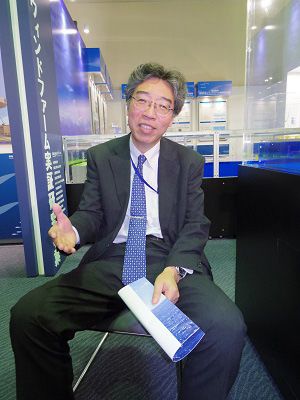 Professor Ishihara Takeshi (Department of Civil Engineering, University of Tokyo).
Professor Ishihara Takeshi (Department of Civil Engineering, University of Tokyo).
FORWARD is a consortium put together by the Ministry of Economy, Trade, and Industry, comprising Marubeni Corporation, the University of Tokyo, Mitsubishi Corp., Mitsubishi Heavy Industries, Japan Marine United Corporation; Mitsui Engineering & Shipbuilding, Nippon Steel & Sumitomo Metal Corp., Hitachi, Furukawa Electric Co., Shimizu Corporation, and Mizuho Information & Research Institute. The project will roll out in two phases, from fiscal 2011 to 2013 and from fiscal 2014 to 2015. The total project cost is ¥18.8 billion, of which ¥12.5 billion has already been expended.
The FORWARD consortium, headed by Marubeni as the project integrator, brings together cutting-edge technologies from leading manufacturers of turbines, floating structures, electric cables, steel materials, and other components. Ten years ago, however, a project like this would have had little chance of getting off the ground.
The person behind the project from the start is the consortium’s technical advisor, Professor Ishihara Takeshi of the University of Tokyo. “The most difficult thing was persuading companies to take part,” he recalls. “Over and over, we had to beg companies that said initially that they couldn’t participate. And the government had to really struggle to raise the money. The nuclear accident of 2011 led to a shift in the way companies saw wind power, but if that year had marked the starting point of our efforts we would never have gotten to the point where we are today. It is only because we have been working on wind power for over ten years that we've been able to bring the project to fruition so quickly.”
The difficulties did not end there, though. “The reality is that even when an excellent technology is developed, it is very hard to get it to the proof-of-concept stage,” Ishihara explains.
“To try to verify a new technology, you need to make a huge investment of time and money. So, very often, it goes no further than simply being a good idea. If you can claw your way out of this ‘Death Valley,’ then for the first time you can start being useful to society and begin to generate positive economic benefits. But we just couldn’t get to that stage. Being able to make the breakthrough this time around has been incredible,” he recalls.
“The momentum for our breakthrough came with the reconstruction of Fukushima, which motivated us to build a renewable energy industry of similar scale to the nuclear power industry. The best way for us to bolster the reconstruction efforts is by creating thousands of jobs for local residents,” he emphasizes.
Benefits for Related Industries and Technologies
The Japan Revitalization Strategy approved by Cabinet decision on June 14, 2013, calls for the commercialization of floating offshore wind power generation by around 2018. The government strategy notes that, just like the case of automobiles or domestic appliances, the production of wind power turbines involves a wide range of related industries and technologies from leading companies. As a result, this new industry has the potential to develop into one of Japan’s export industries.
Wind power turbines have between 10,000 to 20,000 components, roughly similar to automobiles and some electrical appliances. If wind power generation develops, demand for those components will also grow. Moreover, the turbine components have much in common with components used in aircraft, automobiles, and ships, making it an attractive market for existing industries.
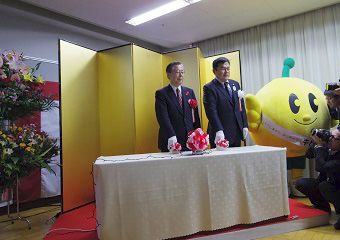 Governor Satō Yūhei of Fukushima Prefecture (left) and Akaba Kazuyoshi, vice minister of the Ministry of Economy, Trade, and Industry, flip the switch to start operation of the Fukushima Floating Offshore Wind Farm in the city of Iwaki.
Governor Satō Yūhei of Fukushima Prefecture (left) and Akaba Kazuyoshi, vice minister of the Ministry of Economy, Trade, and Industry, flip the switch to start operation of the Fukushima Floating Offshore Wind Farm in the city of Iwaki.
The Fukushima Prefectural Government aims to create jobs by amassing large industrial clusters that will include offshore turbine factories and research and development facilities at such sites as the vast Onahama Port in Iwaki or the Hamadōri coastal region of the prefecture.
The expectations for the future are high, as a spokesperson for the Business Setup Group of the Fukushima Prefectural Government’s Commerce, Industry, and Labor Department explains: “While there are not yet any tangible results with regard to wind power, things will really start moving when the experimental studies are completed and the decision is taken to commercialize the technology.”
Prefectural Governor Satō Yūhei sounded hopeful at a ceremony marking the start of operations of the offshore wind farm: “Fukushima Prefecture is facing a very challenging situation as a result of the nuclear disaster. But we aim to make a full recovery and revive our local industries. Our aim is to make Hamadōri an important hub for wind power generation.”
Winning Over Local Fishermen
Important areas for experimental research include the development of forecasting technology for weather and sea conditions, the establishment of technology to predict pitching of the floater, the establishment of floating offshore wind generation as well as voltage transformation technology, and the development of highly functional steel. Even more important, however, is winning public trust that wind farms do not endanger shipping in the surrounding waters. More specifically, this involves convincing the public on the basis of environmental assessments into noise, scenic effects, radio-wave interference, and the impact on commercial marine organisms.
The success of the project is likely to hinge on gaining the understanding of the fishermen in particular. They are concerned that their nets might get caught on moorings or the undersea cables when they are trawling.
However, sensor technology has been developed to prevent net snags. The anchors will be removed when testing is complete. The undersea cables were laid using a special device to loosen the sand on the ocean floor, allowing them to be buried in a meter of sand.
“We can resolve all of these issues using currently available technology,” Professor Ishihara explains, “but we have to actually demonstrate to fishermen that this is the case. For that reason, we decided to let the fishermen see it in action. We have reached an agreement to fish together over the next two years to make sure that there are no problems.”
Verifying that floating offshore wind generation and the fishing industry can coexist and prosper together is crucial to the project’s success.
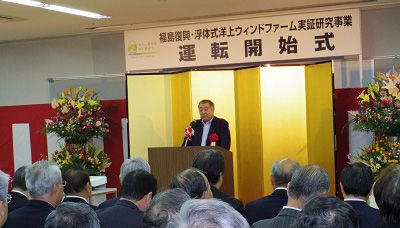 Nozaki Tetsu, chairman of the Fukushima Prefectural Federation of Fisheries Co-operative Associations, delivers a speech.
Nozaki Tetsu, chairman of the Fukushima Prefectural Federation of Fisheries Co-operative Associations, delivers a speech.
Nozaki Tetsu, chairman of the Fukushima Prefectural Federation of Fisheries Co-operative Associations, has been proactive about this collaboration, as he explains:
“Fukushima’s fishing industry, following the nuclear disaster, is still at the stage of exploratory fishing. I’m hopeful that offshore wind power generation will help us revive the local fishing industry.”
This does not mean, however, that fishermen no longer have concerns about the wind farm. One person connected to the project noted that the mood among the fishermen might change next year when two more turbines come on line. Winning the full consent of the public will be no easy task—and may well be one of the biggest challenges facing the project.
(Originally written in Japanese by Nagasawa Takaaki. Banner photo of the Fukushima Kizuna floating substation courtesy of the Fukushima Offshore Wind Consortium.)